Ultimate Guide to Rabbit Care for Pet Owners
Rabbits are beloved pets that bring joy to countless families. Their playful antics and gentle nature make them wonderful companions. Understanding their needs—ranging from their diet to socialization—is crucial for any potential or current rabbit owner. This guide delves into the essentials of rabbit care, providing insights into rabbit breeds, behavior, and health management.
For those considering adopting a rabbit or those who have already welcomed a bunny into their home, grasping the fundamental aspects of rabbit ownership is key. Throughout this article, we will discuss the anatomy of rabbits, their social needs, proper housing, grooming techniques, and dietary requirements, along with care strategies that can help ensure a happy and healthy life for your pet.
By the end of this article, you'll not only understand what it takes to care for a rabbit but also how to nurture a bond that enhances both your life and your pet's. Let's embark on this journey of rabbit care!
Understanding Rabbit Anatomy: A Key to Care
Before diving into rabbit care, it’s essential to understand their anatomy. Rabbits are unique creatures with specialized body structures that directly impact their needs. For example, rabbits have powerful hind legs designed for jumping and a delicate digestive system that requires a high-fiber diet.
Common Physical Traits of Rabbits
Rabbits come in various breeds, each exhibiting different physical traits, including fur texture, ear size, and weight. Some popular breeds include the Holland Lop, Netherland Dwarf, and the English Angora. Understanding these characteristics will help you choose the right breed for your lifestyle and living situations, such as indoor vs outdoor environments.
Rabbit Respiratory and Digestive Systems
The respiratory and digestive systems of rabbits are particularly sensitive. For instance, they are obligate nasal breathers, which means healthy airflow through their noses is essential. Additionally, their digestive tract is designed to process high-fiber foods, making hay a crucial part of their diet.
Rabbit Mobility and Behavior
A rabbit's physical structure allows for extensive movement, highlighting the need for ample space to exercise. Their innate behaviors include digging, hopping, and chewing, which serve both physical and mental stimulation roles. A well-enriched environment will cater to these behaviors, promoting a healthy and happy bunny.
With a solid understanding of rabbit anatomy, we can discuss how to create an ideal habitat for your pet rabbit.
Creating the Perfect Habitat for Your Bunny
A supportive habitat is foundational for maintaining your rabbit’s health and happiness. Whether you choose to keep your rabbit indoors or outdoors, the environment must be safe, spacious, and equipped with enrichment opportunities.
Indoor Rabbit Housing Solutions
For indoor rabbits, space and safety are primary concerns. A large cage equipped with chew-proof materials and enough room for your rabbit to stretch out is vital. Additionally, areas for exercise, such as rabbit-proofed rooms, allow for hopping and exploring. Incorporate climbing toys or tunnels to encourage activity.
Outdoor Rabbit Habitats: What to Consider
Outdoor rabbits require protection from predators and harsh weather. Enclosed rabbit runs can provide fresh air and exercise, but they're best combined with a secure hutch where your rabbit can rest and feel safe. Make sure that these areas are cleaned frequently to maintain hygiene and reduce stress.
Essential Supplies for Rabbit Comfort
Beyond housing, rabbits benefit from various supplies that cater to their needs. Essential items include litter boxes, hiding spots, and a range of toys to prevent boredom. Regularly assess what your rabbit enjoys to ensure an enriched living situation.
Now that we've explored effective housing solutions, let’s delve into rabbit socialization and companionship aspects.
Social Needs and Companionship for Rabbits
Rabbits are social creatures that thrive on interaction. Understanding their social needs is central to preventing behavioral issues and ensuring a satisfying life for your pet.
The Importance of Socialization in Rabbits
Socialization plays a crucial role in a rabbit's mental well-being. Exposure to various environments and gentle handling from a young age can foster positive interactions with humans and other pets. Bunnies that are adequately socialized often exhibit fewer behavior problems and have happier dispositions.
Keeping Your Rabbit Engaged
Keeping your rabbit entertained is essential for mental stimulation. Regular playtime and enrichment activities, such as navigating mazes or solving food puzzles, can enhance behavior and reduce stress. Additionally, create a safe space where they can explore independently while ensuring they are protected from potential hazards.
Adopting a Second Rabbit: Pros and Cons
Bringing in a second rabbit can offer companionship and reduce loneliness. However, it's crucial to consider proper introductions and compatibility. Bonding can take time, and not all rabbits will coexist peacefully. Understanding the social structure of rabbits helps you make informed decisions about introducing a mate.
Having discussed the social aspects of rabbit ownership, we can now look at rabbit health management and preventive care.
Rabbit Health: Preventive Care and Management
Maintaining your rabbit’s health requires regular monitoring and preventive care. Understanding common rabbit health issues and knowing when to seek veterinary guidance can greatly impact your rabbit's lifespan and quality of life.
Regular Veterinary Care for Rabbits
Routine vet check-ups are essential for detecting health issues early. Vaccinations and regular health screenings can help prevent serious illnesses. Consulting with a veterinarian who specializes in rabbit care ensures your pet receives the best possible treatment.
Understanding Common Rabbit Health Issues
All pet owners should familiarize themselves with common rabbit ailments, including dental problems, digestive issues, and respiratory conditions. Recognizing warning signs, such as changes in behavior, appetite, or litter habits, is critical for timely intervention.
Dietary Considerations for Optimal Rabbit Health
A well-balanced diet directly influences a rabbit's health. High-fiber hay should comprise the majority of their nutrition, supplemented by fresh vegetables and limited pellets. Avoid foods that are toxic to rabbits, such as chocolate or certain fruits, and always provide fresh water.
With health management covered, let's turn our focus to grooming and hygiene practices to keep your rabbit looking and feeling great.
Essential Grooming and Hygiene Practices for Rabbits
Proper grooming facilitates good hygiene and can prevent several health issues. Regular grooming sessions not only keep your rabbit clean but also provide an excellent opportunity for bonding.
Grooming Techniques and Frequency
The frequency of grooming depends on the type of rabbit breed. Long-haired breeds may require daily grooming, while short-haired varieties may only need it weekly. Regular check-ups of fur, ears, and nails can help catch potential issues early.
Health Monitoring During Grooming
During grooming, always take note of your rabbit’s skin and fur condition. Look out for any unusual lumps, bumps, or parasites. Early detection of health concerns during routine grooming will help maintain your rabbit's health.
Cleaning Your Rabbit’s Living Space
Maintaining cleanliness in your rabbit’s habitat is critical. Regularly clean litter boxes, replace bedding, and disinfect surfaces to prevent the spread of bacteria and parasites. A clean environment ensures your rabbit remains happy and healthy.
By adhering to sound grooming and hygiene practices, you'll help ensure a happy, healthy life for your pet rabbit. As we conclude this guide, let’s address some common questions about rabbit ownership.

Frequently Asked Questions About Rabbit Ownership
Understanding rabbit ownership can come with its share of questions. Here are a few of the most frequently asked queries regarding rabbits:
How do I train my rabbit?
Training your rabbit can be accomplished through positive reinforcement techniques. Encourage desired behaviors with treats and praise, focusing on consistency to establish a routine.
What do I need for a new rabbit?
Before bringing a new rabbit home, prepare a comfortable habitat, proper food supplies, toys, and a vet for regular check-ups. Ensure the environment is safe and free of potential hazards.
How can I tell if my rabbit is happy?
A happy rabbit displays several behaviors, such as binkying (jumping with joy), grooming themselves, and engaging with their environment. Pay attention to their social interactions and appetite levels as indicators of happiness.
This comprehensive overview of rabbit care, covering essential aspects from anatomy to grooming, aims to empower pet owners with the knowledge to foster a loving relationship with their rabbit. With proper care, rabbits can thrive as cherished family members.

